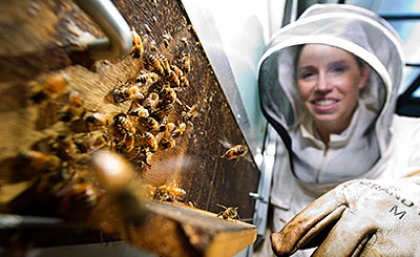
University of Queensland scientists have discovered that genes switch off as memories are being formed, allowing for new connections between nerve cells.
The discovery could eventually lead to a key for treating conditions such as autism and dementia.
Researchers studying honeybees during learning activities have shown that memory management in the bee brain is controlled by small genetic elements called microRNAs that help regulate gene expression.
Queensland Brain Institute researchers Professor Charles Claudianos and Dr Judith Reinhard have led an international team which has discovered that these microRNAs could directly target the key developmental gene ‘actin’, which controls the ability of nerve cells to connect with other nerve cells.
“We believe the brain selectively controls the wiring of memory through microRNAs that switch off key genes that shape, connect and signal between neurons,” Professor Claudianos said.
“The brain is constantly managing all of the sensory experiences we receive at any one time, and retains some of these as memories based on the relative importance or significance of the experience, such as food, danger and sex, to name some examples.
“We are now gaining an insight into how this occurs.
“By understanding how we can control nerve cell development with the technology used in our study, we may eventually help redress disorders such as dementia and autism.
“The current hypothesis in autism is that those brains are over-connected, so getting a grasp of understanding how to regulate neural circuitry could provide future methods of tackling these problems.
“The nervous system behind memory formation is fundamentally no different between a honeybee and a human, so by studying bees we identify the basic biological processes that help us understand humans.”
Dr Reinhard said the research provided a fundamental understanding of how neural circuits were built and consolidated to retain memories.
“Memory is a fundamental component of many mental health disorders, so understanding the basic science behind memories will give us greater insight into many disorders,” she said.
“Human illnesses and diseases such as muscular myopathies, neurodevelopmental disorders and susceptibility to infection are caused by DNA mutations that affect actin and actin-related biological processes.
“Molecules such as microRNAs are thought to have evolved to shape biological processes through controlling the expression genes that function in that process. A single microRNA can control many genes that function in the nervous system.”
QBI researchers collaborated with teams from Universidade de Sao Paulo and Universidade Federal de Alfenas in Brazil and the University of Konstanz in Germany.
Findings of the research are published in Nature Communications.
Media: Darius Koreis, +61 7 3346 6353, d.koreis@uq.edu.au; Professor Charles Claudianos, +61 7 334 66319, c.claudianos@uq.edu.au; Dr Judith Reinhard, +61 7 3346 6321, j.reinhard@uq.edu.au.
.jpg)










